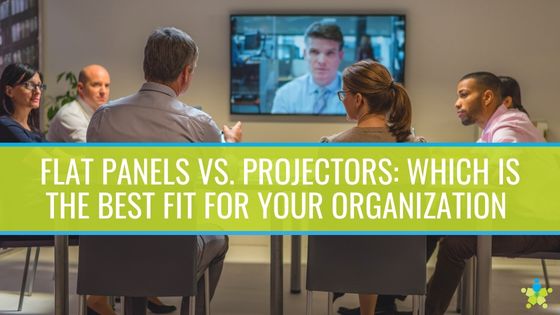[vc_row][vc_column][vc_column_text]
Whether it's a huddle room or a full-blown training auditorium, your meeting spaces will work better with a
digital display. Displays provide critical visual support for any presentation, ensuring everyone in attendance can understand what's being discussed. Digital displays are also major collaboration facilitators because they allow for simple content sharing. People take in information best when it’s presented in multiple formats and displays deliver that information visually.
The question is - what kind of digital display is the best fit for your company's needs? The choice almost always comes down to projectors or flat panels (screens).[/vc_column_text][/vc_column][/vc_row][vc_row][vc_column][vc_column_text]
Digital Flat Panels: Bright, Vivid, Compact and Easy to Operate
Digital panels are the newer, more advanced display technology. As such, they come with several engineering-based advantages that make them a good fit in most spaces.
The most notable is image quality. Most modern LED screens output at 4K resolution, with exceptional brightness and color depth. A flat panel has no trouble delivering crystal clear images in any space, as a result. This is particularly handy for rooms that receive a lot of natural light. Natural light can blow out projector images because projectors don't generate enough light themselves to overcome the brightness. But that's not a problem with digital screens, which look vivid in any lighting conditions.
Digital flat panels are also the preferred option for smaller spaces, as they don't need as much room as a projector to operate. Digital screens are a single-piece display solution built into a compact piece of hardware. If your organization relies heavily on smaller meeting spaces like huddle rooms, digital flat panels are ideal. The screens can be mounted to the wall with no visible cables or mounting hardware, minimizing clutter.
Projectors, in contrast, are two-piece solutions that require space between the projector and wall to operate. This is an obvious limiting factor in small rooms.
A digital screen is also the most familiar and most intuitive display solution for people to work with. They look like consumer TVs and don't require any calibration to work right, every time. And if adjustments to brightness or contrast are needed, users know where to look without getting IT involved. Projectors, though, can be intimidating for people to use, as few have a projector at home. Projectors also require occasional calibration, especially if they are being moved from room to room.
There are also
interactive flat panels that add a tactile element to meetings.
The Clevertouch is one example and allows professional teams to whiteboard, annotate, and collaborate using touch controls. Interactive flat panels are a strong addition to video conferencing solutions, as they can be used by remote participants as if they were in the room.
In summary, if your building is bright and tight on space, digital flat panels are a better option. And, if your employees need a simple solution that works every time, digital screens are again the right fit.
[/vc_column_text][vc_column_text]
Projectors: The Biggest, and Most Economical Image Available
Projectors have been around for decades, but that doesn't mean they're obsolete. In fact, current-generation projector technologies are also capable of color-rich, high-resolution images. They still need the right lighting conditions to look their best, but if those conditions are in place, projectors can power an excellent visual experience.
In large rooms, there may be hundreds of people present during a meeting or training session. If your meeting spaces must accommodate a large number of people, projectors are the popular choice. That's because projectors can be scaled up or down to nearly any size. And a single projector can be calibrated for multiple sizes, so it can be scaled as needed.
Some projectors can output images at extremely large sizes - up to a 300-inch diagonal. This is usually not preferred, as the projector is limited by how much light it can throw at once, which means a larger image tends to be less vivid. However, even at a 90 or 120-inch diagonal, modern projectors can compete with digital flat panels in image quality, as long as lighting conditions are good. And, if a smaller image size is required (like a 60-inch image), projectors can look extremely sharp.
The other main benefit of projectors is their economy. Projectors are the least expensive large format displays available, so they're a common entry-level choice for organizations on a slim budget. It's true that some of this cost advantage is offset by lamp replacement expenses, but in terms of upfront expense, projectors beat out flat panels.
So, where should projectors be featured in your building? In oversized spaces where an oversized image is essential for the audience. Large training rooms, for example, are well-supported by projector technology.
[/vc_column_text][vc_column_text]
For Many Organizations, There's Room for Both
For the vast majority of rooms, digital flat panels are a perfect fit. They only have issues filling out extremely large spaces, and even in this case, there are single flat panels that reach up to 120 inches. There are also
video walls and direct view LED panels that can be pieced together to make displays of any size or shape.
Those solutions can definitely wow an audience, but they're expensive. They may not always be, but for some organizations, there isn't room in the budget for a video wall. In this instance, a projector is the less costly alternative.
[/vc_column_text][vc_column_text]
Can't Decide Between Digital Flat Panels and Projectors? Talk to an AV Integrator
As you can see, there's room for projectors and digital flat panels in most buildings. If you're still not sure which technology should go in your meeting rooms, a certified AV integrator can help. Their expertise with display technology means they can analyze your rooms and select the best fit for each space.
[/vc_column_text][/vc_column][/vc_row]



